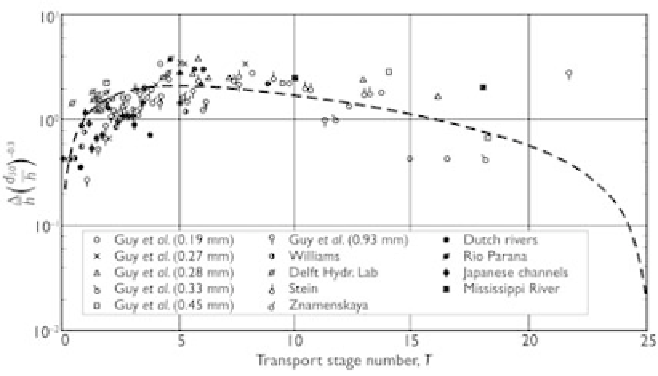Geoscience Reference
In-Depth Information
(1999) suggested direct calculation of the total roughness coefficient of a movable
bed. Van Rijn (1984c) and Karim (1995) established empirical relations to predict the
height of bed forms and then the roughness coefficient on a movable bed. Brownlie
(1983) proposed a formula to determine the flow depth rather than the roughness
coefficient in an alluvial river. The van Rijn, Karim, and Wu-Wang formulas are
introduced below as examples.
Van Rijn formula
Van Rijn (1984c) established a relation for the sand-dune height,
, as shown in
Fig. 3.11 and expressed as
0.11
d
50
h
0.3
h
=
e
−
0.5
T
(
−
)(
−
)
1
25
T
(3.57)
where
T
is the non-dimensional excess bed shear stress or the transport stage number,
defined as
T
U
∗
/
2
1;
U
∗
=
(
U
∗
cr
)
−
is the effective bed shear velocity related to grain
roughness, determined by
U
∗
=
Ug
0.5
C
h
, with
C
h
;
U
∗
cr
is the
critical bed shear velocity for sediment incipient motion, given by the Shields diagram;
and
d
50
and
d
90
are the characteristic diameters of bed material.
/
=
18 log
(
4
h
/
d
90
)
Figure 3.11
Relation of sand-dune height (van Rijn, 1984c).
In van Rijn's method, the length of sand dunes is set as
λ
d
=
7.3
h
, the grain
e
−
25
/λ
d
roughness is 3
d
90
, and the form roughness is 1.1
(
1
−
)
. Therefore, the
effective bed roughness is calculated by means of
e
−
25
/λ
d
k
s
=
3
d
90
+
1.1
(
1
−
)
(3.58)
and the Chezy coefficient is then computed by


